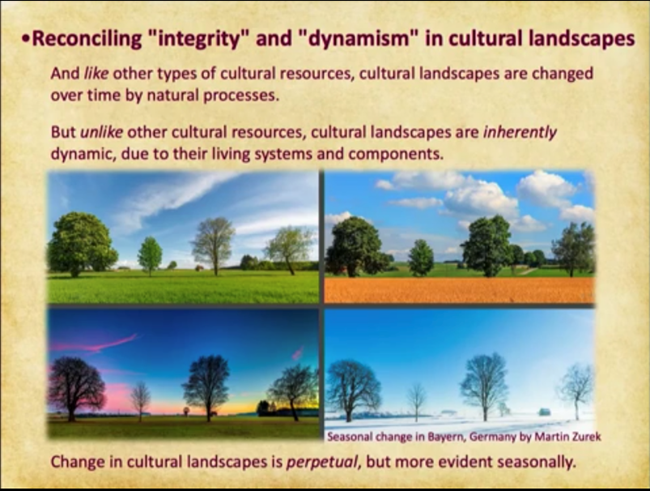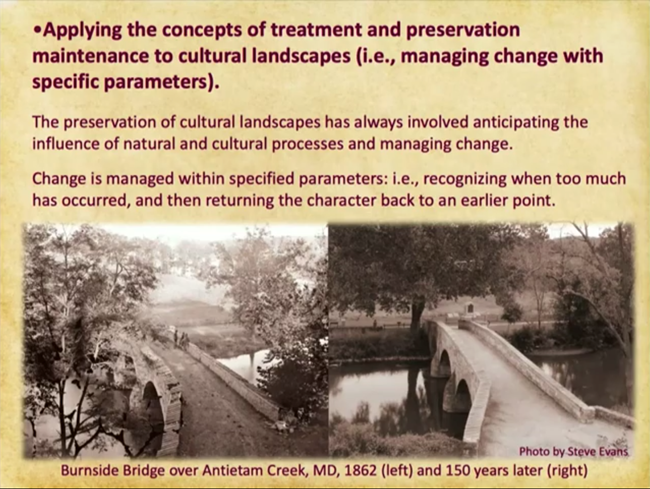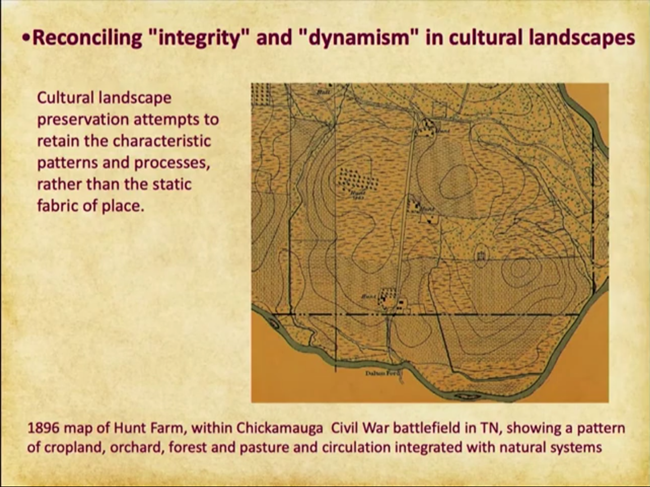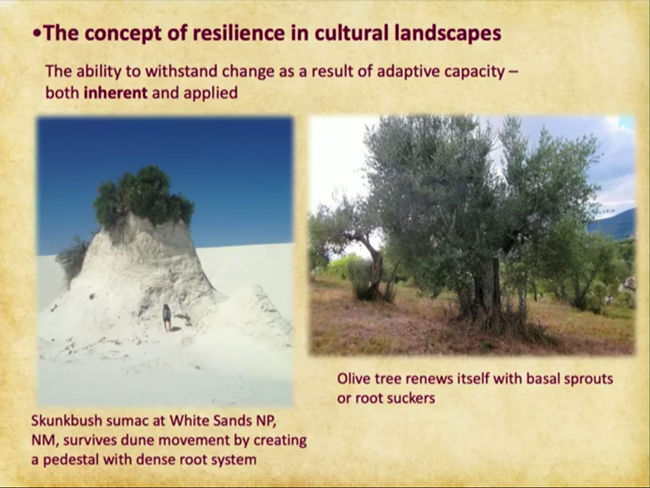Last updated: April 7, 2025
Article
Managing Environmental Change in Cultural Landscapes: Vegetation
National Center for Preservation Technology and Training
This presentation, transcript, and video are of the Texas Cultural Landscape Symposium, February 23-26, Waco, TX. Watch a non-audio described version of this presentation on YouTube.

Martin Zurek
Susan Dolan: I'm going to talk about managing environmental change in cultural landscapes and reconciling first integrity and dynamism that are inherent in cultural landscapes. Applying the concepts of treatment and preservation maintenance to cultural landscapes, i.e. managing change within specified parameters. Then the concept of resilience in cultural landscapes. Then climate change as an accelerant of change in cultural landscapes. An example of a climate change impacts on a specific landscape, and then wrapping up by using preservation maintenance, and rehabilitation treatment to build resilience in cultural landscapes
First of all, reconciling integrity and dynamism in cultural landscapes. We have a conundrum in that integrity or authenticity of place in historic preservation is a measure of relative stasis or lack of change since a period of significance. With integrity, we look at seven qualities of integrity that most of you will have heard of. We're looking for the landscape to have not significantly changed since a period of significance to have integrity.
However, all types of cultural resources and historic places are changed over time by external natural processes such as weathering, erosion, decay, seismic activity, and fire. Like other types of cultural resources, cultural landscapes are also changed over time by natural processes. Unlike other cultural resources, cultural landscapes are inherently dynamic due to their living systems and components. Changing cultural landscapes is perpetual every minute of every day, but most evident seasonally.
Over long timescales, cultural landscapes accrue more change as a result of natural cycles of growth and death, combined with cultural activities. In this example here at Big Hole Battlefield in Montana, we can see a drawing from 1877 and a photograph of the same vantage point 130 years later. Here seeing this cleared slope that was maintained this way by native Nez Perce people, and today maintained this way by the National Park Service. But this takes a cultural process in order to achieve this type of landscape.

Steve Evans
So, while integrity and dynamism may at first seem irreconcilable, they become interwoven in the concept that a cultural landscape is a system of natural and cultural components and processes. The integrity, their integrity is dependent upon the viability of the system as a whole, including the change making processes. Natural and cultural processes must have viability in order to sustain the cultural landscape. To preserve a cultural landscape, we must understand the natural processes and the cultural processes that have sustained the landscape and attempt to preserve these processes.
I think that a major contribution of cultural landscape preservation to the U.S. Field of Historic Preservation has been to clarify that integrity can be measured by the retention of natural and cultural processes and characteristic patterns on the land, as well as the retention of individual features. Many of you in this room, many of you have been contributors to the field of cultural landscape preservation in this state and this nation have really helped to bring about a change in how we see historic preservation as cultural landscapes as a system where retaining natural and cultural processes, as well as those physical things on the land together to watch and retain integrity.
We look for characteristic patterns retained since the period of insignificance to recognize integrity from very large scale to very small scale, and I find it fun to look at this field pattern in Quebec, the French Long Lot system and compare it with the Jeffersonian grid that we have in the Midwest of the United States. It's very large patterns and then very small patterns going here from Spain to Eastern China.
We also look for characteristic processes that have been retained since the period of significance to recognize integrity. We look for both natural processes like natural flooding in rice fields, the course of the pattern of rainfall upon crop land, and here at Chaco Canyon where the great houses were laid out according to lunar and solar cycles that we still can see today. We also look for cultural processes in understanding the integrity of landscapes. Cultural processes might include something like this here at Caw Caw County Park in South Carolina, we can still see these rice trunks that historically were operated by enslaved people to allow saltwater and freshwater to mix and to irrigate rice fields. A cultural process that sustained the rice fields.

National Park Service
A cultural landscape preservation that attempts to retain the characteristic patterns and processes, rather than just the static fabric of place. Here we're looking at a 1896 map of Chickamauga Battlefield in Tennessee showing a mosaic of forest, and fields, and posture, a pattern on the land that was characteristic of this landscape at the time of the battle that we seek to retain today, we seek to retain that pattern that is integrated with natural systems.
The significant character of cultural landscapes is manifest in these characteristic patterns and processes, rather than in specific features. With cultural landscapes we look at the whole, the greater system, and we look here at Gateway Arch National Park grounds in St. Louis, Missouri, the Dan Kiley plan for this landscape in the middle of the 20th century called for a bilateral symmetry to the landscape through the plane of the arch here, which is here, bilateral symmetry. This side reflect on this side, these curvilinear lines that reflect the catenary lines of the arch. These allees of trees reinforce those lines in the circulation system. They reinforce this pattern of bilateral symmetry. These allees of trees are a very strong part of their character defining at Gateway Arch.
Here at Buckner Orchard at a vernacular landscape in Washington state is this grid pattern of trees at 30 feet spacing, trees that date back to 1917 and the spacial organization of these quadrants of trees that are really, really significant in this landscape.
The preservation of cultural landscapes has always involved anticipating the influence of natural and cultural processes and managing change. As we think about the changes that are ensuing with changing climate, in a way, we've always been prepared to manage change in cultural landscapes since their inception, change is what we're about in preserving landscapes. Change is managed within specified parameters, i.e. recognizing when too much change has occurred, and then returning the character back to an earlier point.

Steve Evans
Here we're looking at 150 years separation in this view of Antietam Bridge over Antietam Creek, Antietam National Battlefield in Maryland. It's taken a tremendous amount of management of the landscape in its totality in order to be able to see, and recognize, and feel this character similar today as it was historically. It's taken vegetation management, hydrologic management, circulation management, the whole thing together is necessary in order to retain this character over time. At many times in this last 150 years, trees have grown up and died. Some have been retained, some have been replaced.
The federal government treatment efforts are guided by the Secretary of the Interior's Standards for the treatment of historic properties, and specifically with guidelines for the treatment of cultural landscapes. Regardless what chapter of this document that you're looking in for preservation, for types of treatment, they all embodied this common philosophy. That it is better to maintain than repair, repair than replace, to replace in kind rather than with a substitute, to replace missing features, to replace irreparable features with a compatible substitute, rather than incompatible substitute. That whole philosophy is really embedded in every one of the four treatments.
If we look here as an example of replacing in kind rather than with a substitute, we're seeing the growth and aging of the Olmsted Elm at Fairstead in Brookline, Massachusetts, the home and office of Frederick Law Olmsted and the Olmsted firms successively, and a tree planted by Frederick Sr. We're seeing that that tree eventually went into a pattern of decline as a result of Dutch Elm disease and was in fact replaced with a young tree in the last couple of years. This type of activity is driven very much by the standards, by the guidelines. This is how we perpetuate and preserve cultural landscapes that are dynamic, constantly changing, aging, dying. We replace in kind in order to preserve that landscape.
Managing change according to the standards involves understanding the overall character and how the character is associated with significance. Here we are back to the Gateway Arch grounds in St. Louis, Missouri and we're seeing the allay of trees I mentioned earlier that was so important in reinforcing the bilateral symmetry of the Dan Kiley design in the mid-20th century. The park, following the secretary's standards, over time would replace trees, trees within the allay were replaced in a partial tree replacement efforts. You can see here's a younger tree, these are older trees, but they're all being replaced on the same spacing with the same species as the historic ones. This is an acceptable treatment under the standards. Then so is this.
The park got to a certain point in recent years where the threat of Emerald Ash Borer was going to take out these trees and they were in decline. They were topping out their lifespan and the park went ahead and replaced them all wholesale. Both of these are possible under the Secretary of the Interior's Standards. It's a way of managing change in cultural landscapes.
Something I find really, really exciting is the concept of resilience in cultural landscapes. The concept of resilience is the ability to withstand change as a result of adaptive capacity. That capacity can be both inherent and applied externally. Applied meaning the kind of things that we can do to build resilience in landscapes.

Susan Dolan, National Park Service
I want to show you a couple of species here that have inherent resilience. I find it just delightful. This skunk bush sumac in White Dunes National Park, now national park was a national monument in New Mexico, develops this incredibly dense root system when it is inundated by a sand dune. Once the sand dune has moved on as of course sand dunes migrate, the roots continue to form an extremely stable pedestal that keeps the plant alive and in place, even though the sand dune has now moved on.
An example of olive trees that sprout from their base, basal sprouts or root suckers, and literally renew themselves over time from the ground. There are many species that are basal sprouting and renew themselves. Actually the longevity of species like this that renew themselves from the ground is unknown. Some of the species in the world with the greatest longevity are olive trees over 5,000 years old as they just keep renewing themselves. Example of resilience.
In terms of applied resilience, something that's so important is that we build resilience through actions that enhance soil fertility. This might seem like a very detailed, very specific point, but the health of landscapes, the resilience of landscapes is very much tied to the health of soils. That soils are an ecosystem of microorganisms that enable life to thrive in them. That much of the work that we need to do to maintain and preserve landscapes needs to be focused on sustaining the fertility of soil. Soil is an ecosystem that provides fertility. If you could see this, you could see a web of life in the soil that makes nutrients available. Water. It's a cycle, beautiful system.
Turning briefly to climate change, so climate change as an accelerant of change. We know that we have more carbon dioxide in the atmosphere now than we've had in 500 million years. As a result, in the 20th century, we saw temperature changes throughout the United States. We saw also when we can look to see projected change in temperature in the 21st century that will result in increasing temperatures pretty much everywhere. When we look at precipitation in the 20th century, there have been vast changes in precipitation patterns. As we look ahead to the 21st century, the pattern of precipitation is anticipated to change quite dramatically from much wetter to much drier.
The phenomena of climate change are often associated with warmer and wetter winters, warmer and drier summers, and more frequent storms. Those phenomena play out in disease infestation, drought, fire, erosion, flooding, invasive species, and the migration of culturally significant species typically to more Northern latitudes, and wind damage and other phenomena that are happening more frequently.
A very specific example, one example of climate change on a specific landscape, let's just take a look at the moment in the Eastern United States where woolly adelgid is one of the exotic pests introduced into United States from Asia that has had a tremendous impact on the native eastern hemlock tree. The spread of the pest is now from new England right through to the Southeast, along the Appalachian Mountains, basically in the natural habitat range of the eastern hemlock.
Now, if you look at one landscape in particular, Rapidan Camp, Robert mentioned this morning and in Shenandoah National Park, historically, this was the summer white house for the Hoovers during the Hoover administration. President Hoover and his wife would spend their time at Rapidan Camp in Shenandoah in Virginia in this beautifully cool, shady atmosphere of hemlock trees. A rustic encampment that was clustered in amongst an eastern hemlock forest that helped cool them and give them respite and relaxation.
Well today, with the infestation of woolly adelgid, the hemlock trees have been killed. Rapidan Camp no longer has eastern hemlock forest that provided that shady, cool atmosphere. Instead, the succession for forest of Tulip Poplars has emerged. As a result of analyzing and planning, during the planning that comes with a cultural landscape report treatment plan, the National Park Service has determined that this successional forest of Tulip Poplar should be allowed to remain as a nurse forest cover that will eventually give rise to a new generation of eastern hemlock trees. The eastern hemlock requires shade for it to generate, and if the Park Service’s attempt to replant hemlock right now, it would require a lot of pesticide treatment to keep the woolly adelgid at bay. Instead, the managing change here is evolving, allowing this natural processes of succession to help us cultivate another generation of eastern hemlocks in the future.
We can use preservation maintenance as well as rehabilitation treatment to build resilience in cultural landscapes. Preservation maintenance actions, sustain the cultural processes and promote resilient conditions. If I could leave you with one thought today is that we cannot take the culture out of cultural landscapes without essentially losing them. They'll be transformed without our input. There must be culture in cultural landscapes. Examples of preservation maintenance here at the Buckner Orchard that we'll hear more about, winter pruning, summer pruning, mowing, mulching, fertilizing irrigation, irrigation integrated pest management, propagating to replace declining trees, replanting replacing trees in kind, even providing sun scald protection for young trees, which is the white paint that goes on bark to prevent them being peeled by sun, sun damage.
All of these things help to sustain the resilience, but also perpetuate these practices that have always been part of this place. If these practices were taken out, the system then is devoid of that process that it needs to sustain itself. Just one example here of repair. Here, bridge grafting is an example of a repair technique at Buckner Orchard. You remember in the standards, it's better to repair than replace? Well, a historic fruit tree that has a cavity in it at Buckner Orchard can be repaired by this bridge grafting technique, an ancient technique where you take shoot growth from the canopy, the scion wood, and you graft it across the cavity in order to eventually it grafts, and merges, and restores connectivity from the scion to the root stock. An example of repair is bridge grafting.
In terms of examples of rehabilitation in building resilience, rehabilitation actions make compatible alterations that build resilience. This is of course the applied adaptation rather than the inherent adaptation that the Skunk Bush Sumac had at White Sands National Park. As an example of that here at Buckner Orchard, we have a need to replace trees that die, but rather than replace them in kind that we would replace, say a Jonathon tree with a Jonathon tree in the future, more often now we are replacing trees that die with the Rome Beauty variety.
Historically, the orchard had four varieties, and out of all of these varieties, the Rome Beauty is by far the strongest, is the one the tree that's always the most muscular looking. It's just really drought resistant and extremely well adapted to that place. As an example of making a compatible alteration, we're now putting back more Rome Beauties than Jonathan's or other varieties, because the climate here is becoming drier in the summertime. This is an example of us helping along the resilience of this cultural landscape.
Finally, leaving you with this thought, that natural and cultural processes must have viability working in tandem to sustain the cultural landscape. That to preserve a cultural landscape, we must understand the natural processes and the cultural processes that have sustained this landscape over time, and attempt to preserve these processes together.
Thank you.

National Park Service
Speaker Biography
Susan Dolan is a Historical Landscape Architect and Manager of the U.S. Department of the Interior (USDI), National Park Service, Park Cultural Landscapes Program. Her responsibilities include developing, implementing and overseeing a service-wide landscape preservation program that includes research, planning, stewardship, education and technology development. She previously served as the Historical Landscape Architect for Mount Rainier National Park.
She has undergraduate and graduate degrees in landscape architecture from the University of Oregon and an undergraduate degree in horticulture from Reading University in England.
Publications include: “Orchard Management Plan for Manzanar National Historic Site,” United States Department of the Interior (USDI), National Park Service, Pacific West Regional Office, 2011; “Fruitful Legacy: A Historic Context of Orchards and Fruit Trees in the National Park System, from 1600 to the Present,” USDI, National Park Service, Olmsted Center for Landscape Preservation and Pacific West Regional Office, 2009, and “Orchard Management Plan for John Muir National Historic Site,” USDI, National Park Service, Pacific West Regional Office, 2006.
